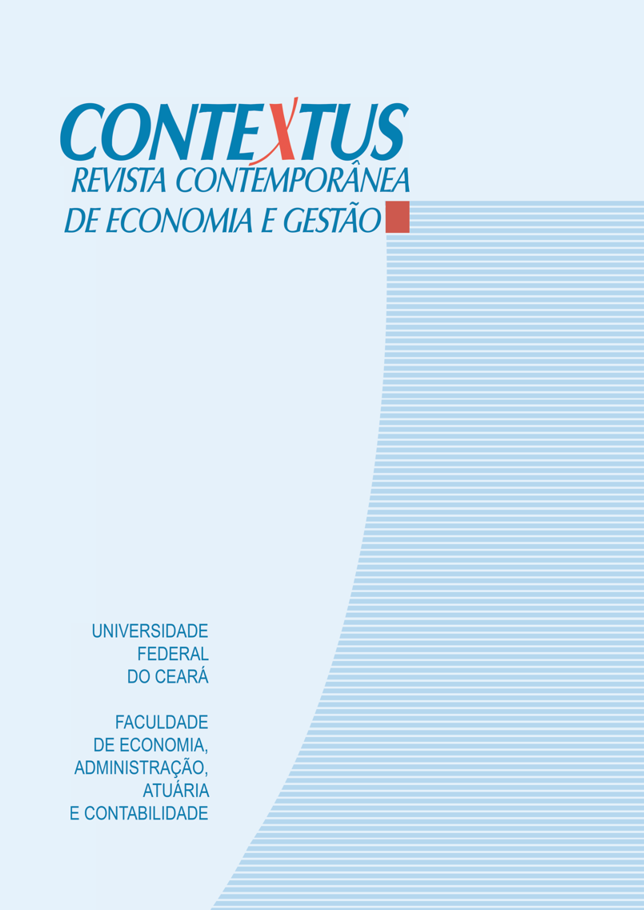HOW MUCH HEAVIER IS A “HOE” FOR WOMEN? WAGE GENDER DISCRIMINATION IN THE BRAZILIAN AGRICULTURAL SECTOR
DOI:
https://doi.org/10.19094/contextus.v17i2.39969Abstract
This paper aims at analyzing the existence of wage differentials by genders in the agricultural labor market in the Brazilian rural area, with the purpose of verifying if the differentials are due to differences in explained characteristics or discriminatory. Equations were estimated and the wage differential detailed decomposition with microdata from the PNAD 2015 with the Heckman's correction. The method used was the decomposition of Oaxaca-Blinder. The main results show that the wage/hour of men is 157.62% higher than that of women, and the effect of discrimination is 108.38% this gap. The main conclusion indicates that the gender wage differential decreases with the formality of work and with the increase of hours worked by women. It is worth nothing that the results provide the visualization of gender discrimination in the rural labor market, adding contributions to the empirical studies on wage differentials.
References
AGRAWAL, T. Gender and caste-based wage discrimination in India: some recent evidence. J Labour Market Res. v. 47, p.329-340, 2014.
AGUILAR, A. A., CARRANZA, E. B., GOLDSTEIN, M. C., KILIC, T. D., OSENI, G. D. Decomposition of gender differentials in agricultural productivity in Ethiopia. Agricultural Economics, v. 46, n. 3, p.311-334, 2015.
ARROW, K. Higher education as a filter. Journal of Public Economics, v.2, n.3, p.193-216, 1973.
ARULAMPALAM W, BOOTH AL, BRYAN ML. Is There A Glass Ceiling Over Europe? Exploring the gender pay gap across the wage distribution. Industrial & Labor Relations Review, v. 60, n. 2, p.163-186, 2007.
ASSIS, R. S.; ALVES, J. S. Hiato salarial entre homens e mulheres no Brasil segundo condição migratória: o mercado de trabalho é segregado ou discrimina? Revista Econômica do Nordeste, v. 45, n. 1, p.120-135, 2014.
BECKER, G. S. Human capital: a theoretical and empirical analysis, with special reference to education. Chicago: The University of Chicago Press, 1964.
BECKER, G. S. The economics of discrimination. Chicago: Univ. Chicago Press, 1957.
BERGOLO, M.; CARBAJAL, F. Exploring the urban-rural labor income gap in Uruguay: a quantile regression decomposition. Revista de Análisis Económico, v. 25, n. 2, p.133-168, 2010.
BIGLER, C.; AMACKER, M.; INGABIRE, C.; BIRACHI, E. Rwanda's gendered agricultural transformation: A mixed-method study on the rural labour market, wage gap and care penalty. Womens Studies International Forum, v. 64, p.17-27, 2017.
BLINDER, A. S. Wage discrimination: reduced form and structural estimates. Journal of Human Resources, v. 8, n. 4, p.436-455, 1973.
BRASIL. Lei n. 10.097, de 19 de dezembro de 2000. Altera dispositivos da Consolidação das Leis do Trabalho – CLT. Available in: <http://www.planalto.gov.br/ccivil_03/Leis/L10097.htm> Accessed in: 12 de july de 2018.
CARVALHO, A. P.; NERI, M. C.; SILVA, D. B. Diferenciais de Salários por Raça e Gênero: Aplicação dos procedimentos de Oaxaca e Heckman em Pesquisas Amostrais Complexas. Ensaios Econômicos da EPGE, v. 638, 2006.
CEPEA. Centro de Estudos Avançados em Economia Aplicada. 2017. PIB Agronegócio Brasil CEPEA-USP/CNA, jan/dez 2017. Available in: <http://www.cepea.esalq.usp.br/pib/> Accessed in: 11 july 2018.
CEPEA. Centro de Estudos Avançados em Economia Aplicada. 2018. Mercado de trabalho/Cepea: Remuneração no agro cresce mais que a da média brasileira. Available in: <https://www.cepea.esalq.usp.br/br/mercado-de-trabalho-do-agronegocio.aspx> Accessed in: 11 july 2018.
CIRINO, J. F.; LIMA, J. E. DE. Diferenças de rendimentos entre as regiões metropolitanas de Belo Horizonte e Salvador: uma discussão a partir da decomposição de Oaxaca-Blinder. Revista Econômica da Nordeste, v. 43, n. 2, p.371-389, 2012.
COELHO, A. M.; CORSEUIL, C. H. Diferenciais salariais no Brasil: um breve panorama. Textos para Discussão, n. 898, p. IPEA, 2002.
CORREA, A. M. C. J.; FIGUEIREDO, N. M. S. Distribuição de Rendimentos na agricultura brasileira: uma análise exploratória com informações das PNAD´s. Pensamento & Realidade, v. 19, p.5-38, 2006.
CUNHA, M. S. Os empregados da agricultura brasileira: diferenciais e determinantes salariais. RESR, v. 46, n. 3, p.597-621, 2008.
DOERINGER, P. B.; PIORE, M. J. Internal labor market and manpower analysis. Heath Lexington Books, 1971.
DOLTON, P.J.; MAKEPEACE, G.H. Sample selection and male-female earnings differentials in the graduate labour market. Oxf. Econ. Pap. v. 38, n. 2, p.317-341, 1986.
EWING, B.T.; LEVERNIER, W. An analysis of Rural-Urban Differences in Average Family income: An Aplication of the Oaxaca and Cotton-Neumark Decomposition Techniques. The Review of Regional Studies, v. 30, n. 3, p.299-314, 2000.
GARIBALDI, P. Personnel economics in imperfect labor markets. Oxford, England: Oxford Press, 2006.
GOLLIN, D.; LAGAKOS, D.; WAUGH, M. E. The Agricultural Productivity Gap. The Quarterly Journal of Economics, Oxford University Press, v. 129, n. 2, p.939-993, 2014.
GUIMARAES, C. R. F. F.; SILVA, G. Pay gap by gender in the tourism industry of Brazil. Tourism Management, v. 52, p.440-450, 2016.
HAISKEN-DENEW, J.P.; MICHAELSEN, M.M. Migration Magnet: The role of work experience in rural-urban wage differentials in Mexico. Ruhr Economic Paper, n. 263, 2011.
HEADEY, D. D.; JAYNE, T. S. Adaptation to land constraints: Is Africa different? Food Policy, v. 48, p.18-33, 2014.
HECKMAN, J. J. Sample selection bias as a specification error. Econometrica, v. 47, p.153-161, 1979.
HLAVAC, M. Oaxaca: Blinder-Oaxaca Decomposition in R. R package version 0.1.4. Available in: <https://CRAN.R-project.org/package=oaxaca> Accessed in: 10 de july de 2018.
HOFFMANN, R. Distribuição da renda e pobreza na agricultura paulista. São Paulo em Perspectiva, v. 7, n. 3, p.107-115, 1993.
HOLDEN, S. T.; OTSUKA, K. The roles of land tenure reforms and land markets in the context of population growth and land use intensification in Africa. Food Policy, v. 48, p.88-97, 2014.
IBGE – Instituto Brasileiro de Geografia e Estatistica. Estatísticas de Gênero Indicadores sociais das mulheres no Brasil. Estudos e Pesquisas, Informação Demográfica e Socioeconômica, Rio de Janeiro, n. 38, 2018.
IBGE – Instituto Brasileiro de Geografia e Estatistica. Sistema de Contas Regionais: Brasil 2015. Contas Nacionais, n. 57, ISSN 1415-9813, 2017.
KASSOUF, A. L. Wage gender discrimination and segmentation in the Brazilian labor market. Economia Aplicada, v. 2, n. 2, p.243-269, 1998.
MAHAJAN K., RAMASWAMI B. Caste, Female Labor Supply, and the Gender Wage Gap in India: Boserup Revisited. Economic Development and Cultural Change, v. 65, n. 2, p339-378, 2017.
MINCER, J. Schooling, experience and earnings. Columbia University Press, 1974.
NEY, M. G.; HOFFMANN, R. Educação, concentração fundiária e desigualdade de rendimentos no meio rural brasileiro. Rev. Econ. Sociol. Rural, v. 47, n. 1, p.147-181, 2009.
NOLTE, K.; OSTERMEIER, M. Labour Market Effects of Large-Scale Agricultural Investment: Conceptual Considerations and Estimated Employment Effects. World Development, v. 98, p.430-446, 2017.
OAXACA, R. Male-female wage differentials in urban labor markets. International Economic Review, v. 14, n. 3, p.693-709, 1973.
OECD – Organisation for Economic Co-operation and Development. Glossary of statistical terms, 2001. Available in: <http://stats.oecd.org/glossary/detail.asp?ID=1264> Access in: 20 july. 2018.
PESSOA, D. G. C.; SILVA, P. L. N. Análise de dados amostrais complexos. In: 13º SIMPÓSIO NACIONAL DE PROBABILIDADE E ESTATÍSTICA. Anais... São Paulo, Brasil, Associação Brasileira de Estatística, 1998.
PHELPS, E. S. The statistical theory of racism and sexism. The American Economic
Review, v. 62, n. 4, p.659-661, 1972.
SCHULTZ, T. W. O valor econômico da educação. (P. Werneck, Trad.) Rio de Janeiro: Zahar, 1967.
SKINNER, C.J.; HOLT, D.; SMITH, T.M.F. Analysis of Complex Surveys. Chichester: John Wiley & Sons, 1989.
TELLES, E. Who Gets Formal Sector Jobs? Determinants of Formal-Informal Participation in Brazilian Metropolitan Areas, Works and Occupations, v. 19, p.108–27, 1992.
TRIVENTI, M. The Gender Wage Gap and Its Institutional Context: A Comparative Analysis of European Graduates. Work Employment and Society, v. 27, n. 4, p.563-580, 2013.
UNDP. Human Development Report 2016, United Nations Development Programme, 2016.
VIETORISZ, T.; HARRISON, B. Labor market segmentation: positive feedback and divergent development. American Economic Review, v. 63, n. 2, p.366-376, 1973.
WORLD BANK GROUP. Women, Business and the Law 2018. Washington, D.C.: Grupo Banco Mundial. Licença: Creative Commons Attribution CC BY 3.0 IGO, 2018.
WORLD BANK. World development indicators: Rural environment and land use: Environment, 2016. Available in: <http://wdi.worldbank.org/table/3.1#> Accessed in: 13 December 2018.
Published
How to Cite
Issue
Section
License
The authors, while doing the submission, accept the notice below:
We authors hold the copyright related to our paper and transfer Contextus journal the right for the first publication with a Creative Commons’ international license of the modality Attribution – Non-commercial 4.0, which in turn allows the paper to be shared providing that both the authorship and the journal’s right for initial release are acknowledged.
Furthermore, we are aware of our permission to take part in additional contracts independently for non-exclusive distribution of the version of our work published in this journal (e.g. publishing it in an institutional repository or as a book chapter), while acknowledging both the authorship and the journal’s initial publication.
We also certify that the paper is original and up to this date has not been released in any other journal, Brazilian or of another nationality, either in Portuguese or another language, as well as it has not been sent for simultaneous publication in other journals.
Last, we not only know that plagiarism is not tolerated by Contextus but also certify the paper presents the sources of passages from cited works, including those authored by ourselves.









3.png)


1.jpg)



1.jpg)


1.jpg)






.jpg)



1.jpg)

1.jpg)


1.jpg)

1.jpg)
1.jpg)
2.png)




1.jpg)
2.jpg)

1.jpg)





1.jpg)


1.jpg)
1.jpg)
